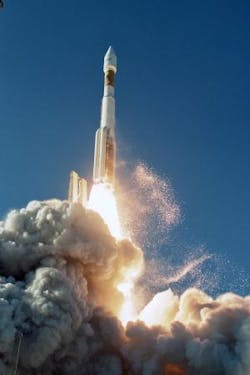Former NASA Administrator Griffin urges government to reduce dependence on Russia, proactively pursue space, and clearly define goals and policy
NAME: Dr. Michael Griffin
TITLE: Chairman and CEO
CO.: Schafer Corp.
ROLE: provider of technology services and solutions for customers with missions of national significance in aerospace and national security
CONTACT: www.schafercorp.com
A former NASA administrator discusses current and future aerospace opportunities and challenges, including U.S. dependence on foreign aerospace technologies and capabilities.
Are you seeing more commercial or government/defense aerospace activity?
It is true that when you talk about aerospace, people generally think about two commercial markets: aviation and communication satellites. That was, literally, the only commercial space market 40 years ago. While civil aviation was important, they were doing so much [U.S. Department of Defense (DOD)] work that most of the civil transportation was derived from Defense Dept. designs. The 707 in the ’60s emerged as the KC-135 tanker, for example. At that time, aerospace across the board was dominated by what the government did; and now, there’s commercial imaging, commercial rockets, and lots of people working on commercial crew vehicles.
In civil aviation, the Boeing 787 doesn’t come from any DOD airplane. Boeing developed [the Dreamliner] as a commercial product. The commercial market today is much different and stronger. That is one of the real opportunities.
How can governments and militaries take advantage of commercial aerospace trends?
There is so much commercial satellite traffic, or rather commercial imaging traffic, that it is not unreasonable for the DOD to consider flying some of its payloads as passengers on what would be a commercial flight—and do so for a fraction of the cost. Once the hosted payload capabilities are in place, it is reasonable to [populate payloads with] sensors; there are endless possibilities.
What challenges do aerospace engineers face?
We need better definition of what the government aerospace sector intends to do. We have a rather poorly defined set of space policies, both civil and military. They’re not what they were in previous years but, at the same time, are not clearly defined. What [the U.S. Congress expects] NASA to be doing is not that clear, nor is a long-term commitment to space programs.
In the U.S., the aerospace community is in the midst of a study on what are we going to do about engines to power Atlas rockets given difficulties with Russia over the Ukraine situation. We buy our engines for the Atlas rocket from Russia. Most of Congress was not aware of that until recently. A study on alternatives is ongoing. It is late to be thinking about that. Nonetheless, what the U.S. wants to do in the aerospace arena is more than a little uncertain. It would be helpful if that were clarified. What do we need? Government constitutes a very large portion, the largest portion, of what this nation does in aerospace; yet, it is difficult for commercial aerospace entities to know where they should be investing.
What are your predictions for the future?
In the short term, not much will change. The government sector will be hard pressed to make reductions in discretionary spending. The U.S. has been at war for more than 10 years. Money has gone more into that and less into new capabilities, and that is not going to change right away. Longer term, when we take a deep breath and look at the world situation—Iran gaining more capabilities and more societies that are near-peers in capabilities—and look at the potential for adversarial actions, the U.S. is not going to want to be falling behind. I predict a five- to ten-year period of reinvestment in government aerospace across the board; otherwise, the U.S. will be accepting a secondary status as a nation. So, not much change in the near term followed by a period of reinvestment.
Michael Griffin is a senior technology contributor and leader, with extensive experience serving the national interest in government, industry, and academia. Before joining Schafer, he served as the 11th Administrator of the National Aeronautics and Space Administration (NASA), from April 2005 to January 2009 and most recently was Eminent Scholar and Professor of Mechanical and Aerospace Engineering at the University of Alabama in Huntsville.
Prior to his nomination as NASA Administrator, Griffin was the Space Department Head at Johns Hopkins University’s Applied Physics Laboratory, President and Chief Operating Officer of In-Q-Tel, Inc., and served in several positions within Orbital Sciences Corporation, including Chief Executive Officer of Orbital’s Magellan Systems division and General Manager of the Space Systems Group.
Earlier in his career, Griffin served as Chief Engineer and as Associate Administrator for exploration at NASA, and as Deputy for Technology at the Strategic Defense Initiative Organization. He has been an adjunct professor at the University of Maryland, Johns Hopkins University, and George Washington University, where he taught courses in spacecraft design, applied mathematics, guidance and navigation, compressible flow, computational fluid dynamics, spacecraft attitude control, astrodynamics and introductory aerospace engineering.
Griffin holds seven academic degrees, including: a B.S. in Physics from Johns Hopkins University; a M.S. in Aerospace Science from Catholic University of America; a Ph.D. in Aerospace Engineering from the University of Maryland; a M.S.E. in Electrical Engineering from the University of Southern California; a M.S. in Applied Physics from Johns Hopkins University; a M.A. in Business Administration from Loyola College; and a M.S.E. in Civil Engineering from George Washington University.



